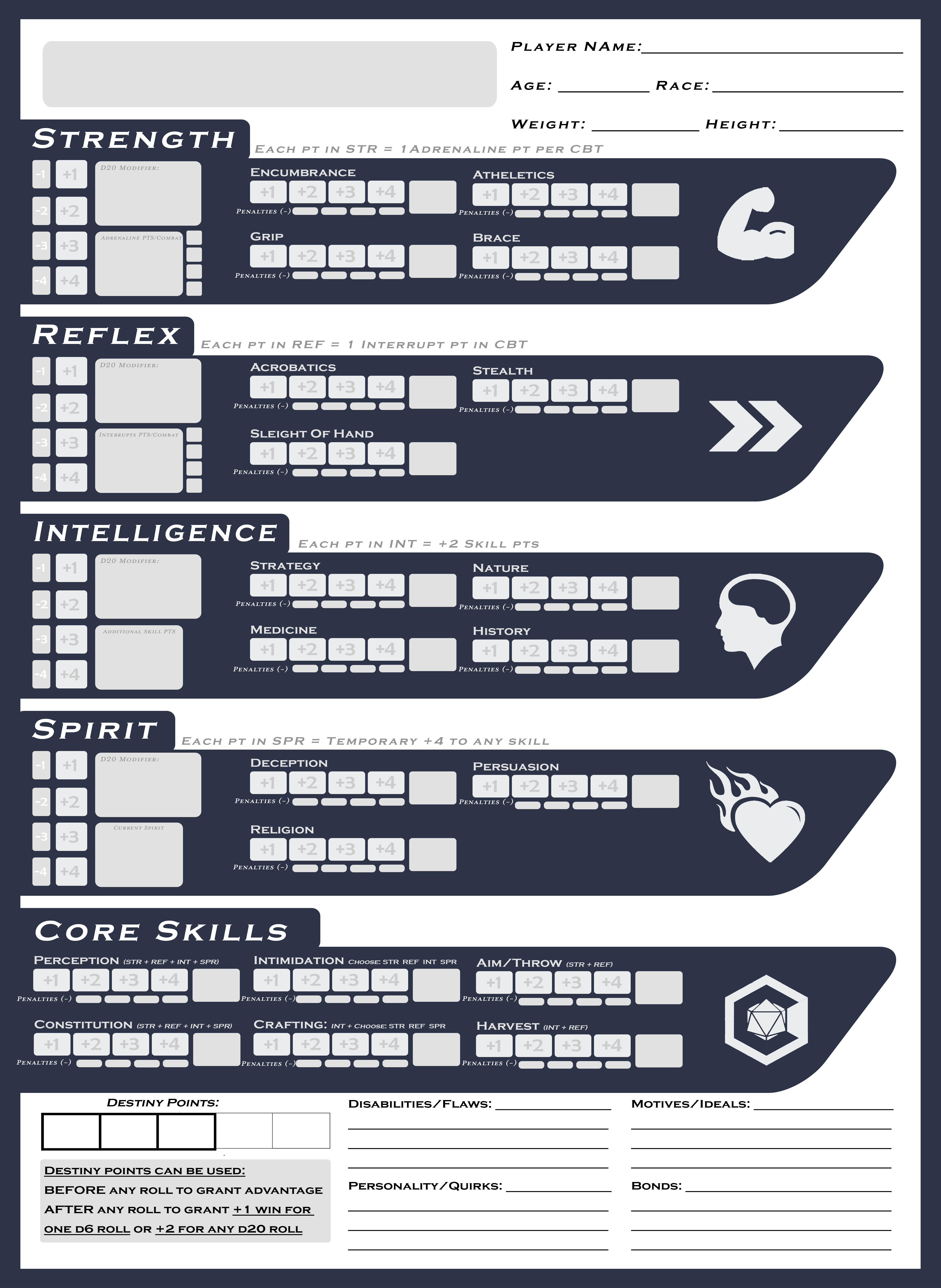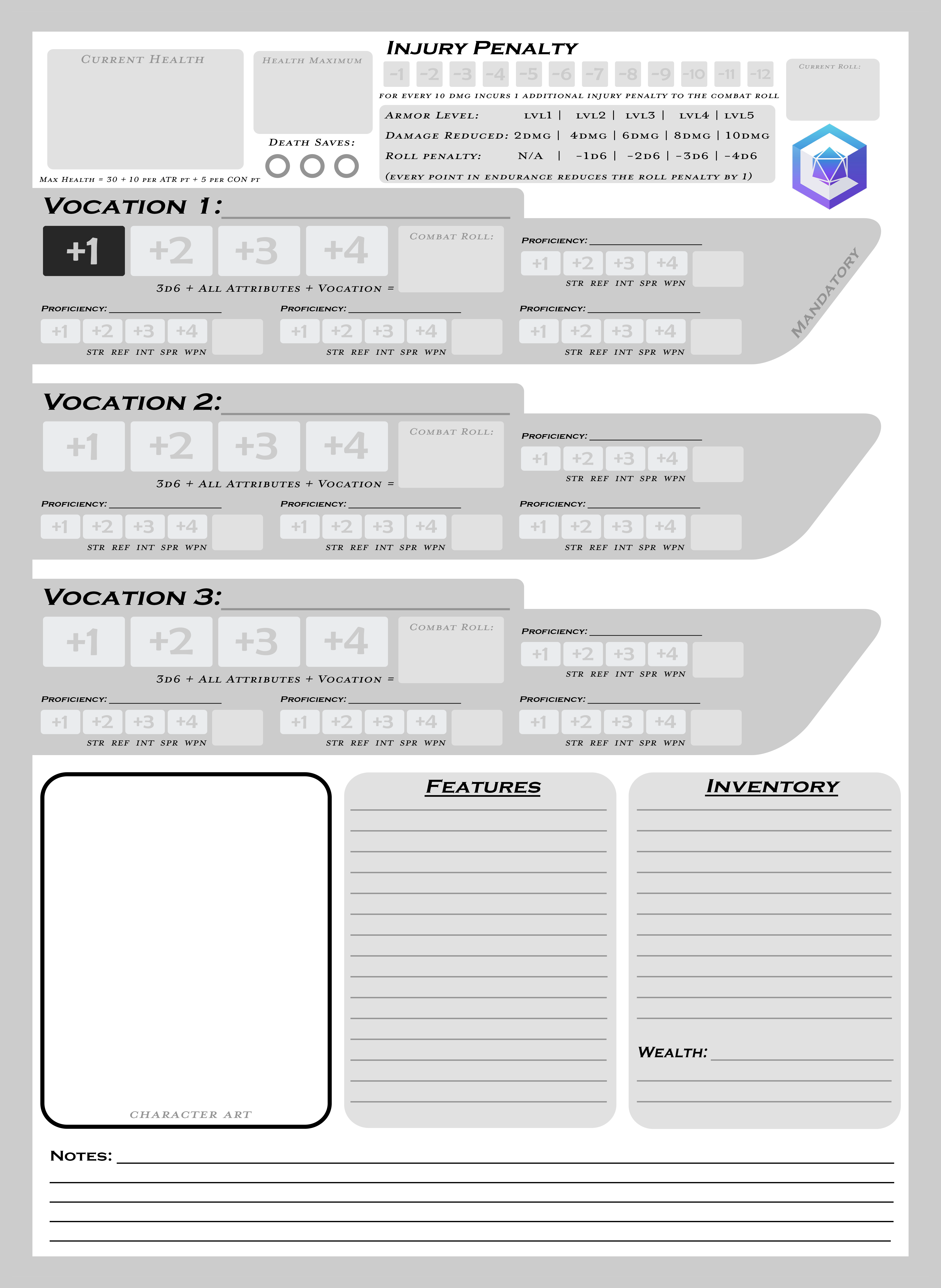Gameplay Rules
There are several modifications that have been made to the original ruleset of Cogent Roleplay that this campaign will be using. The following are House Rules that may replace or alter the original rulebook.
- A fourth Attribute called Spirit has been added to the Character Sheet. This attribute represents your strength of heart, depth of personality, force of will, or sensitivity to the spiritual realm. Attribute abilites have been modified.
- STR - Every point in STR grants 1 Adrenaline point per combat. Adrenaline points can be spent to reduce victory level acheived by an opponent on you by 1 level each. You may spend multiple adrenaline points at once. Adrenaline points reduce victory levels, armor points reduce actual damage. Adrenaline points reset at the beginning of combat.
- REF - Add your reflex modifier to your initiative roll. Every point in REF grants 1 interrupt point per combat. You may use an interrupt point on any turn that is not your own to interrupt the action being taken on that turn. For this round of combat, you are moved out of your initial position in the initiative order and placed directly before the target of the interrupt. The target's turn is still considered declared and may not be changed. You may then take your turn with the knowledge of what will be happening next. You may not do this if you have already taken your turn this round. An interupt can be used in response to another interupt. Each player or enemy may only spend one interupt per round. Once the round finishes, all players and enemies return to their intial initiative order. Interrupt points are reset at the beginning of combat.
- INT - Each point in INT grants 2 additional skill points to be spent anywhere.
- SPR - You may reduce your SPR score by 1 to give any skill a temporary +4. This does not stack on top of any bonuses you previously had, it instead changes any one skill into a +4. The next time you roll for that skill, the skill reverts to it's original score after the roll is resolved. You may spend multiple SPR points on multiple skills, but only one SPR point per one skill. SPR points and skill scores reset after a long rest. Several Skills have been added or changed. Many of these are now based on multiple Attributes and are known as core skills.
- Perception is now a core skill based on all attributes.
- Constitution is a core skill. based on all attributes
- Intimidation is a new skill. You choose what attribute you want it to be based on.
- Crafting is a new skill based on INT and another attribute of your choice.
- Throw has been changed to Aim/Throw and is based on REF and STR
- Harvest is a new skill based on INT and REF
- Religion is a new skill based in SPR
- Deception and Persuasion have been moved to SPR based
- Infiltrate has been changed to strategy
- General Knowledge has been removed and split into History and Religion
- Survival has been removed and split into Medicine and Nature
- Endurance has been changed to Encumbrance
- Brace is a new skill based in STR
- Swim has been removed as a skill
- For skill checks, players roll a d20 and add their relevant score for that skill rather than multiple d6's. Scores are calculated the same as before. In combat, players WILL be rolling multiple d6's and calculating victory levels as before but damaging the enemy will be different. In addition to this, a player's combat roll is calculated slightly different. A player now rolls a number of d6's equal to 3d6 + 1d6 per attribute point + 1d6 per vocation point in the vocation they are currently using + 1d6 per proficiency point that is currently being used.
- Commerce points will not be used in this ruleset
- BEFORE any roll to grant advantage
- AFTER any roll to grant +1 win for one d6 roll OR +2 for any d20 roll
- Disadvantage and Advantage: For a d6 - Normally a 4, 5, or 6 represents a success on any given roll. Advantage increases that to 3, 4, 5, or 6 and Disadvantage decreases that to 5, or 6. For a d20 - roll twice, take the higher number.
- Initiative is determined by rolling a d20 and adding your reflex. Priority is given in numerical order with higherst numbers going first. Weapons Categories and mechanics have changed entirely. The new weapon categories are listed below. The ranges for weapons in combat has been extended. From nearest to farthest the new ranges are:
- Close Combat
- Melee
- Extended Melee
- Short Range
- Mid Range
- Long Range. Any weapon being used outside it's specified range has disasdvantage on it's roll to hit.
Small Weapons
Daggers, Brass Knuckles, Hatchet, etc. Unarmed is considered a small weapon. Close Combat range. | Dual Wield allowed. | Throw allowed. | 1d6 + proficiency damage. | 1d6 + doubled proficiency damage when in close combat | Piercing: 0Medium Blunt
Staffs, Sledgehammer, Clubs, etc.| Melee range. | Dual Wield Allowed. | Throw allowed. | Versatile. | 1d8 + proficiency damage. | Piercing: 1Medium Blade
Shortsword, Longsword, Axe, etc. Melee range. | Dual wield allowed. Throw allowed. | Versatile. | 1d8 + proficiency damage. | Piercing: 1Heavy Blunt
Greatclub, Two handed Mace, Warhammer, etc. | Melee range. | You may attack multiple targets adjacent to one another all at once using your combat roll for this weapon. Roll your damage die for each target seperately. | 1d10 + proficiency damage. | Piercing: 2Heavy Blades
Battle Axe, etc. | Melee range. | You may attack multiple targets adjacent to one another all at once using your combat roll for this weapon. Roll your damage die for each target seperately. | 1d10 + proficiency damage. | Piercing: 2Reach Weapons
Spear, Glaive, Flails, etc. | Melee or Extended Melee range. | Throw allowed. | -3d6 in close combat.| 1d6 + 1d4 + proficiency damage. | Piercing: 3Short Range Stringed
Shortbow, Slings, etc. | Short Range. | 1d8 + proficiency damage. | Piercing: 1Short Range Ballistic
Handguns, etc. | Short Range. | Dual wield allowed. | 1d8 + proficiency damage. | Piercing: 2Thrown Weapons
Grenades, Throwing Stars, etc. | Short Range. | Throw allowed. Dual Wield Allowed. | 1d8 + proficiency | Piercing: 0Mid Range Stringed
Longbowbow, Crossbow, etc. | Mid Range. | 1d10 + proficiency damage. | Piercing: 2Mid Range Ballistic
Rifles, Shotguns, etc. | Mid Range. | 1d10 + proficiency damage. | Piercing: 3Heavy Ranged
Canons, Bazookas, Catapults, Ballistas, etc. | Long Range. | 1d12 + proficiency damage. | Piercing: 5
Only weapons listed with the "throw allowed' can be thrown. When throwing a weapon increase it's effective range by 1 distance level and add your Aim/Throw score to the roll to hit. The weapon drops to the ground once it hits anything in it's path.
Only weapons listed with the "dual wield allowed' can be dual wielded. When dual wielding a weapon roll to hit twice and and roll damage twice adding the appropriate proficiency both times. Apply range to each weapon separately. You may attack two targets when dual wielding, using one weapon each.
At GM's discretion, many Medium weapons can be 'Versatile' meaning you can choose whether you are using one or two hands with it. When you are using two hands, you may no longer dual wield or throw any weapons. When using two hands with a versatile weapon increase it's damage die by 1 size.
- During combat, players and enemies now deal damage to one another, determined by rolling damage dice. Players and enemies now also have a number on their sheets reperesenting their current health and maximum health. A character's maximum health is calculated as such: 30 + 10 per attribute point + 5 per Constitution point
- When a players health reaches 0, they begin making death saving throws on their turn by rolling a d20. 2-10 is a fail and 11-19 is a success. A natural 1 is two fails and a natural 20 is two succeses. On three failures the player's character is now dead. On three succeses a player is restored to 1 health point and is unconcious.
- Every 10 health a character loses incurs a -1d6 penalty to their total combat roll. Every 10 health a character gains removes a -1d6 penalty to their total combat roll. The GM may also choose to incur more permanent penalties (such as after losing a limb) that can not be removed by gaining health
- When you have a negative modifier applied to your Attributes, do not count them when determining max health. Only positive attribute points apply to max health. However when you have a negative Constitution point, you will subtract 5 health from your max health. Similarly,negative points in Attributes or combat skills do reduce the total number of dice you roll in combat. Add all positive points as d6's and then remove a d6 for each negative point.
- Any player can attempt to heal another using their medicine skill and any other applicable skills determined by the GM or their vocation. When healing, a player rolls a number of d6's equal to Medicine points + other relevant skills. For every success the target is healed 10 health points. This can not go above max health except by magical means.
- A short rest restores half the total amount of damage a player has taken. A long rest is defined by a minimum 8 hours of sleep or minimal activity. A long rest restores maximum health points. The GM determines what type of rest is allowed at a given time.
- Armor reduces damage. The 5 levels of armor reduce increasing amounts of damage as they get higher as well as imposing higher penalties to the combat roll. Every point in Encumbrance you have reduces the penalty of your armor by one armor level.
- Whenever you take damage the armor your wearing will reduce the damage your taking by the amount associated with it's level everytime. That is unless the weapon attacking you has an equal or higher piercing level than your armor level. In these cases the armor does nothing for damage prevention against that type of weapon and is considered compromised on hit.
- Compromised armor is weakened from damage. Whenever an attack compromises your armor reduce your armor level equal to the difference between it and the piercing level of the attack. For example, if the attacker uses a spear (piercing 3) against level 2 armor, the armor becomes compromised and is reduced to level 1 armor (3 - 2 = 1). Armor can be repaired with crafting checks specific to the armor set by the GM.
- Just like with Adrenaline points, armor has a one time effect to reduce victory levels (as oppossed to damage). This allows players that do not play to Strength builds to still have access to this ability, just in a weaker capacity. Whenever an enemy gets one or more victory levels over you, you may choose to compromise all your armor levels, and reduce the victory levels gained by 1 for each armor level lost this way. Shields are an exception to this rule and can be used to use this ability without compromising the rest of your armor.
- Armor can have special properties that make it extra resilient or weak to types of damage as well as other special properties. Knowing the specific capabilities of your armor is important
- You may wear multiple sets of armor when realisticly possible. Your armor level will be equal to the sum of all the sets together with a maximum of 5. Armor levels are pooled together and as such you may lose one set of armor (and the abilites it grants) but still retain the armor levels from the other. Which armor breaks at what time is determined by the GM.
- Lvl 4 armor imposes a -1 penalty to stealth and Lvl 5 imposes a -2 penalty to stealth.
- When in combat, players and enemies are rolling multiple d6's and determing victory levels as normal. However the victory level options have changed. No matter what victory level is acheived, the player or enemy with the higher roll rolls their damage die for their weapon OR chooses one of the options below instead.
- Level 1 Victory - Disarm
- Level 2 Victory - Stagger (-2d6 to next combat roll only)
- Level 3 Victory - Trip (5 damage and knocked prone)
- Level 4 Victory - Dismember (10 damage and remove a limb) OR roll damage and add +15 damage
- Level 5 Victory - Death Blow (Drop opponents health to 0)
Destiny points can be used:
This Campaign is written using a ruleset inspired by the Cogent Roleplay Ruleset with many adaptations. The original rulebook can be found here.






Comments